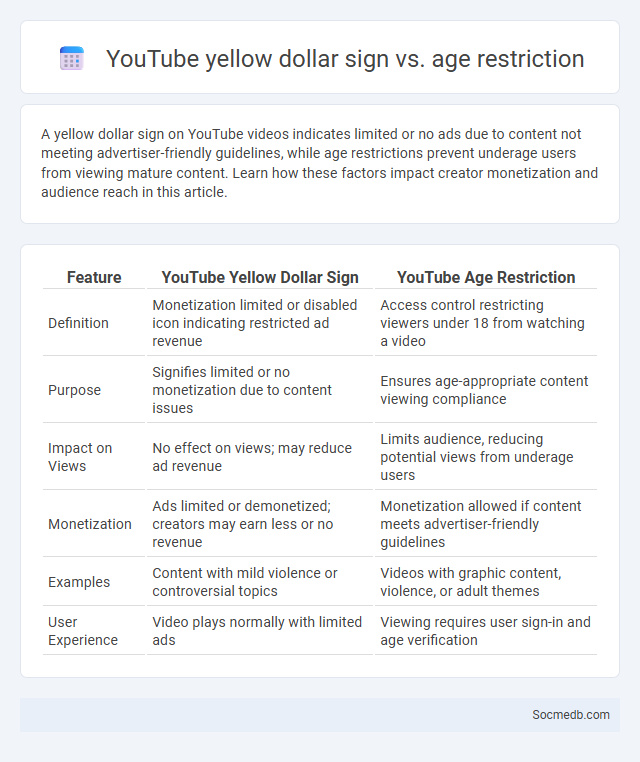
Photo illustration: YouTube yellow dollar sign vs age restriction
A yellow dollar sign on YouTube videos indicates limited or no ads due to content not meeting advertiser-friendly guidelines, while age restrictions prevent underage users from viewing mature content. Learn how these factors impact creator monetization and audience reach in this article.
Table of Comparison
| Feature | YouTube Yellow Dollar Sign | YouTube Age Restriction |
|---|---|---|
| Definition | Monetization limited or disabled icon indicating restricted ad revenue | Access control restricting viewers under 18 from watching a video |
| Purpose | Signifies limited or no monetization due to content issues | Ensures age-appropriate content viewing compliance |
| Impact on Views | No effect on views; may reduce ad revenue | Limits audience, reducing potential views from underage users |
| Monetization | Ads limited or demonetized; creators may earn less or no revenue | Monetization allowed if content meets advertiser-friendly guidelines |
| Examples | Content with mild violence or controversial topics | Videos with graphic content, violence, or adult themes |
| User Experience | Video plays normally with limited ads | Viewing requires user sign-in and age verification |
Understanding the YouTube Yellow Dollar Sign
The YouTube Yellow Dollar Sign indicates limited or no ads on your video, usually due to content that may not be advertiser-friendly. This status affects your monetization potential, reducing your earnings from ads on that specific video. To maximize your revenue, review your content guidelines and adjust your video to comply with YouTube's advertiser policies, ensuring your audience and YouTube both benefit.
What Does Age Restriction Mean on YouTube?
Age restriction on YouTube means that certain videos are only accessible to viewers who are 18 years or older, designed to protect younger audiences from inappropriate or mature content. This policy helps ensure that content involving violence, explicit language, or adult themes complies with YouTube's community guidelines. When you encounter an age-restricted video, YouTube requires you to verify your age by signing in, which controls and limits access based on legal requirements and platform standards.
How the Yellow Dollar Sign Affects Monetization
The yellow dollar sign on social media platforms often indicates limited monetization eligibility due to content guidelines or copyright restrictions. When this symbol appears, creators face reduced or no ad revenue, impacting their overall earnings and incentivizing stricter compliance with platform policies. Understanding the yellow dollar sign's implications helps influencers and marketers optimize content strategies for maximum monetization.
Age Restriction vs. Yellow Dollar Sign: Key Differences
Age restriction on social media platforms limits access to content based on users' age to comply with legal regulations and protect minors from inappropriate material. The yellow dollar sign symbolizes limited monetization, often applied to videos with sensitive content that might not meet advertisers' guidelines. Understanding the distinction is crucial for content creators aiming to maximize reach while adhering to platform policies and monetization standards.
Common Reasons for Receiving a Yellow Dollar Sign
Receiving a yellow dollar sign on social media typically indicates limited or no ad revenue is generated from a video due to content that may include copyrighted music, potentially inappropriate material, or reused content without significant original commentary. This status often arises when automated systems detect violations of platform monetization policies, including community guidelines or advertiser-friendly content criteria. Creators facing a yellow dollar sign should review platform rules and consider editing their videos to comply with content guidelines to regain full monetization privileges.
Impact of Age Restriction on Channel Growth
Age restrictions on social media channels significantly influence audience demographics and engagement rates, often limiting exposure to younger users essential for rapid subscriber growth. Platforms enforcing strict age-related access can experience slower channel expansion due to reduced viewership and interaction from core adolescent segments. Analyzing data from YouTube and TikTok reveals channels with fewer age barriers typically achieve higher growth velocity and broader demographic reach.
Avoiding the Yellow Dollar Sign: Content Best Practices
Avoiding the yellow dollar sign on social media requires creating authentic, engaging content that resonates with your audience without appearing overly promotional. Emphasizing storytelling, user-generated content, and genuine interactions fosters trust and increases organic reach. Prioritize value-driven posts, clear calls to action, and consistent brand voice to maintain credibility and encourage meaningful engagement.
How Age Restrictions Influence YouTube SEO
Age restrictions on YouTube significantly impact your channel's SEO by limiting video visibility and reducing engagement metrics like views, watch time, and shares, which are crucial ranking factors. Content flagged with age restrictions often experiences lower algorithmic promotion, leading to decreased exposure in search results and suggested videos. Ensuring compliance with age-appropriate guidelines enhances your content's discoverability and improves overall video performance on the platform.
Resolving Yellow Dollar Sign and Age Restriction Issues
Resolving yellow dollar sign and age restriction issues on social media platforms requires understanding the specific guidelines that cause limited monetization and content visibility. You should review platform policies on advertiser-friendly content and comply with age verification processes to regain full access to monetization features and audience engagement. Consistent adherence to these rules ensures your content remains monetizable and accessible to the appropriate age groups.
YouTube’s Monetization Policies: Staying Compliant
YouTube's Monetization Policies require creators to adhere strictly to guidelines on content originality, copyright, and advertiser-friendly standards to maintain eligibility for revenue generation. Compliance involves avoiding prohibited content such as hate speech, violence, and misinformation, and ensuring videos meet community standards and copyright laws. Regular updates to policies necessitate that creators stay informed and adjust their content strategies to sustain monetization opportunities.
 socmedb.com
socmedb.com